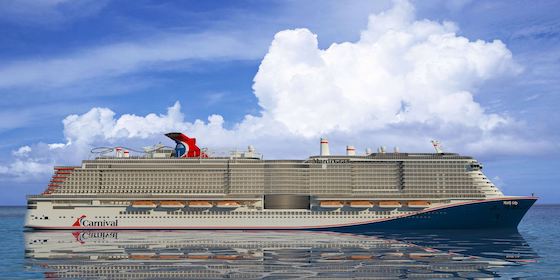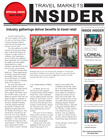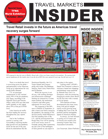Cruises have restarted, and with COVID now part of our life for the foreseeable future, people are learning to live with vaccines, boosters and other health and safety protocols as they return to leisure activities.
With Carnival Cruise Lines reporting they will be back to sailing nearly 90% of their U.S.-based capacity by next February, Giora Israel Sr. Vice President, Port and Destination Development Group at Carnival Corporation, and David Candib, Vice President, Development & Operations, Global Port & Destination Development Group, spoke exclusively with TMI about the company’s focus on private island destinations, whether or not to open new home ports outside of the United States, and the efforts that the company took at the port level to return to safe cruising.
Spotlight on Private island enhancements
Candib, who is responsible for Carnival Corp.’s four port destinations in the Caribbean – Mahogany Bay in Roatan, Puerta Maya in Cozumel, Amber Cove in the Domincan Republic, and the Grand Turk Cruise Center in the Turks and Caicos, as well as the company’s regional Spanish language destinations, will add two more ports to his portfolio on December 1.
On that day, Carnival Corp takes over responsibility for two ports in the Bahamas: Half Moon Cay and Princess Cay, which were operated initially by Holland America and Princess until the companies merged. Half Moon, and Princess Cay, which is part of the island of Eleuthera, are visited by Princess, Carnival and Holland America ships.

Giora Israel, Sr Vice President, Port and Destination Development Group at Carnival Corporation (right) and The Bahamas Prime Minister Hubert A. Minnis, with the agreement to develop Grand Port and Half Moon Cay in Sept. 2019.
As part of the takeover, Carnival signed an agreement with the Bahamian government to build two new cruise ports – one of which will include investing in a pier on the north side of Half Moon Cay to accommodate cruise ships. The current facility on the south side of the island does not have deep water docking and requires the use of tenders for cruise passengers to embark and disembark.
“Carnival will have two simultaneous operations on Half Moon Cay,” explains Candib. “The existing operations with the tenders will remain on the south side of the island (this was created by Holland America in 1998) and we will build the pier on the north side, so that for the first time ships can come alongside. We are now working on finalizing the approval process, permits and licenses.”
“Half Moon Cay is always one of the top rated private destinations for Carnival and HAL guests and this will give us the opportunity to enhance that welcome center, and to create some retail opportunities that we hadn’t had before. We will be exploring opportunities with potential operators in the near future,” he said.
“Half Moon Cay has one of the most beautiful beaches anywhere on the globe,” comments Giora Israel. “The plan is to make it easier for our passengers and welcome guests from the our larger ships, such as Carnival’s new Mardi Gras.”
In terms of Carnival’s other Caribbean port destinations, Mahogany Bay upgrades were completed during COVID, just weeks before arrival of the Mardi Gras. And both Amber Cove and Puerta Maya have reopened under carefully designed protocols. The Grand Turk Cruise Center has not opened yet. Carnival Corporation is investing an additional $25 million in the area, which offers shore excursions, shopping, restaurants and bars (such as Margaritaville), beaches, and pools.
“The new investment includes modifying the pier so it will be able to accommodate the Mardi Gras,” says Israel.
“We are working with the government to finalize a return to sailing and will have more information shortly,” adds Candib.
New Grand Port project
In addition to the existing ports and private islands, Carnival’s biggest project is a $100+ million port development on Grand Bahama.
“As previously announced, this project– to be called Grand Port, a working title– is scheduled to be the largest port development that we have undertaken as a company for a transit port,” said Candib.
“We are very excited about it and we are working with the government of the Bahamas with the permitting and licensing process, and hopefully will move forward after the Bahamian elections.”
The concessions at the Grand Bahamas port differ from those of the other Carnival ports, which are overseen by the company.
“All of the food & beverage and retail will be operated by third parties, not by Carnival. Hopefully, many qualified Bahamian operators will participate. Carnival will be reaching out for proposals once all the permitting and licensing is completed,” said Candib.
The Home porting question
While the CDC refused to lift its Conditional Sail Order and allow cruise ships to set sail from U.S. ports, the cruise industry made waves in mid-March when Crystal Cruises announced it was launching a series of seven-night round-trip voyages from Nassau, avoiding any U.S. ports. The cruise line reported a bookings rush.
Four days later, Royal Caribbean announced it would relaunch its Caribbean cruise service in June, also from a home port in Nassau, and subsequently announced new homeports in Bermuda and St. Maarten as well.
But Carnival Corp. said that it would wait for the CDC to approve the cruise start-up and sail from its U.S. ports.
“From our experience, a cruise product for North Americans from the Caribbean has never succeeded, with two exceptions – a homeport in San Juan and, at times, luxury travel like Seaborne out of St. Maarten or Barbados. Every attempt in the last 40 years, including from Carnival (we tried from Santo Domingo, Celebrity tried out of Aruba) did not succeed,” said Israel.
“To a North American passenger, sailing from a home port in the Caribbean—although it was tried many times – has never worked. Even with San Juan, we had begun canceling some calls because of decreasing demand, and this was before COVID. So even as some competitors were announcing new home ports, we thought that if something doesn’t work at the best of times, why will it work at the worst of times?” he said.
“Maybe we would have taken such action if cruising didn’t open eventually, but not at that moment,” he added.
But U.S. sailings began again in July and most of the other home ports stopped operating, says Israel.
“Ultimately they canceled the Bermuda sailings, and Jamaica and the Dominican Republic. Celebrity operated 7-8 calls out of St. Maarten, but it didn’t really work,” he said.
Not only did the flights to the Caribbean home ports add to the cost of the cruise, but the complexities of flying back with large, bulky gifts and spirits, negatively impacted shopping, he observed. “These cruise passengers visiting Cozumel from the Bahamas bought nearly zero liquor, we were told, because of the costs involved with flying home with it,” he said.
Caribbean home ports for Europeans
Having said that, Israel tells TMI that Carnival Corp. has the largest home port operations in the Caribbean– but for its European brands.
“We are operating home ports from Montego Bay for Aida, from La Romano for Aida and Costa, from Guadeloupe for the French division of Costa, from Barbados for Aida and P&O, (P&O has been the biggest home port user out of Barbados for the last decade), also from St. Lucia and Antigua.
“We are using home ports in the Caribbean extensively for our European guests, using multiple companies and multiple ports,” he said.
The difference is that in the U.S., cruise companies are selling a national product, while in Europe, they can sell on a country by country basis, he explains.
“In the U.S. we depend on the scheduled commercial air system, with its hub and spoke system. We depend on this massive air lift where several airlines feed passengers through many hubs to bring in our passengers. In Europe, we need only a few chartered planes to deliver passengers—5 planes from the UK to Barbados can cover 80% of the British population within 90 minutes driving time, for example. In Italy we can get nearly all the people from four airports. In France we use Paris and Leon. In Germany we use five airports. In the U.S., we would need charters from about 50 cities.”
“So for this reason, we see North American cruising for Americans in the Caribbean and Central America will continue from U.S. ports,” he confirms.
Carnival Cruise Lines announced on Oct. 7 that it had carried nearly 237,000 passengers on almost 100 sailings since resuming service July 3. Carnival is operating 11 ships – nearly half its fleet –from six U.S. home ports along the East and West Coasts and the Gulf of Mexico and says it plans to have 17 ships back in guest service by the end of 2021. Additional ships will return in January and February and the entire U.S. fleet should be back in guest operations by spring 2022.










